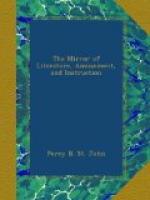By the way, we have just received Mr. St. John’s Anatomy of Society, which we hope to notice in our next or subsequent number.
[3] Why is the a omitted?
* * * * *
THE MONUMENT.
Once the object of general praise, from its loftiness and beauty, and till now the subject of censure, even among Protestants, from that inscription of which the Papists always complained, was the offspring of this period, and realized one of those decorations which Wren had lavished upon his air-drawn Babylon. This lofty column was ordered by the Commons, in commemoration of the extinction of the great fire and the rebuilding of the city: it stands on the site of the old church of St. Margaret, and within a hundred feet of the spot where the conflagration began. It is of the Doric order, and rises from the pavement to the height of two hundred and two feet, containing within its shaft a spiral stair of black marble of three hundred and forty-five steps. The plinth is twenty-one feet square, and ornamented with sculpture by Cibber, representing the flames subsiding on the appearance of King Charles;—beneath his horse’s feet a figure, meant to personify religious malice, crawls out vomiting fire, and above is that unjustifiable legend which called forth the indignant lines of Pope—
“Where London’s column pointing
to the skies,
Like a tall bully, lifts his head and
lies."[4]
The shaft, deeply fluted, measures fifteen feet diameter at the base, and diminishing according to the proportion of its order, terminates in a capital, crowned with a balcony, from the centre of which rises a circular pedestal, bearing a flaming urn of gilt bronze. The various notions of the architect concerning a suitable termination, are worth relating:—“I cannot,” said he, “but commend a large statue as carrying much dignity with it, and that which would be more valuable in the eyes of foreigners and strangers. It hath been proposed to cast such a one in brass of twelve feet high for a thousand pounds. I hope we may find those who will cast a figure for that money of fifteen feet high, which will suit the greatness of the pillar, and is, as I take it, the largest at this day extant. And this would undoubtedly be the noblest finishing that can be found answerable to so goodly a work in all men’s judgments.” The King preferred a large ball of metal gilt. A phoenix was introduced in the wooden model of the pillar, but afterwards rejected by the architect himself, “because it would be costly, not easily understood at that height, and worse understood at a distance; and lastly, dangerous by reason of the sail the spread wings would carry in the wind.” A statue of Charles, fifteen feet high, on a pedestal of two hundred, would have looked small and mean; the King resisted the compliment. This work, begun in 1671, was not completed till 1677;




